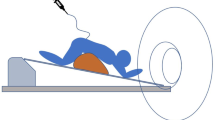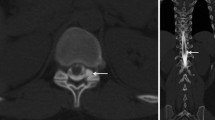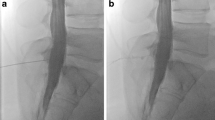Abstract
Purpose
Both CT myelogram (CTM) and digital-subtraction myelogram (DSM) can be used to evaluate patients for possible cerebrospinal fluid (CSF) leaks. DSM is a relatively new technique. No data exists on the radiation dose associated with this procedure, and how it compares with CTM.
Materials and Methods
All patients who underwent DSM for spontaneous intracranial hypotension (SIH) refractory to blood patching from Dec 2016 – Sept 2019 were retrospectively assessed. DSM dose factors were then recorded (cumulative fluoroscopy time, total kerma area product (KAP, mGy.cm2), cumulative air kerma (mGy), as well as CTM dose factors (included CTDIvol (mGy) and dose-length product (DLP, mGy.cm). These indices were then used to calculate the effective dose for both procedures using standardized conversion factors.
Results
61 DSMs were performed in 42 patients, 33 of which also underwent CTM. The median effective dose was 6.6 mSv per DSM study (range: 1.2 – 17.7). On a per-patient basis (i.e. those patients who underwent more than one DSM (as the initial one was negative), the median total effective dose was 13 mSv for their total DSM imaging (range: 2.6 –31.7). For the CTM, the median effective dose was 19.7 mSv (range: 3.2 – 82.4 mSv).
Conclusion
The radiation dose with DSM appears to be significantly lower than that of CTM (p = 0.0005), when looking at CTM doses both from our institution and in the published literature.


Similar content being viewed by others
References
Kranz PG, Luetmer PH, Diehn FE, Amrhein TJ, Tanpitukpongse TP, Gray L. Myelographic Techniques for the Detection of Spinal CSF Leaks in Spontaneous Intracranial Hypotension. AJR Am J Roentgenol. 2016;206:8–19.
Kranz PG, Gray L, Amrhein TJ. Decubitus CT Myelography for Detecting Subtle CSF Leaks in Spontaneous Intracranial Hypotension. AJNR Am J Neuroradiol. 2019;40:754–6.
Farb RI, Nicholson PJ, Peng PW, Massicotte EM, Lay C, Krings T, terBrugge KG. Spontaneous Intracranial Hypotension: A Systematic Imaging Approach for CSF Leak Localization and Management Based on MRI and Digital Subtraction Myelography. AJNR Am J Neuroradiol. 2019;40:745–53.
Schievink WI, Maya MM, Moser FG, Prasad RS, Cruz RB, Nuño M, Farb RI. Lateral decubitus digital subtraction myelography to identify spinal CSF-venous fistulas in spontaneous intracranial hypotension. J Neurosurg Spine. 2019 Sep 13:1–4. https://doi.org/10.3171/2019.6.SPINE19487.
Dobrocky T, Mosimann PJ, Zibold F, Mordasini P, Raabe A, Ulrich CT, Gralla J, Beck J, Piechowiak EI. Cryptogenic Cerebrospinal Fluid Leaks in Spontaneous Intracranial Hypotension: Role of Dynamic CT Myelography. Radiology. 2018;289:766–72.
Luetmer PH, Mokri B. Dynamic CT myelography: a technique for localizing high-flow spinal cerebrospinal fluid leaks. AJNR Am J Neuroradiol. 2003;24:1711–4.
Schauer DA, Linton OW. NCRP Report No. 160, Ionizing Radiation Exposure of the Population of the United States, medical exposure--are we doing less with more, and is there a role for health physicists? Health Phys. 2009;97:1–5. https://doi.org/10.1097/01.HP.0000356672.44380.b7.
Bongartz G, Golding SJ, Jurik AG, Leonardi M, van Persijn van Meerten E, Rodríguez R, Schneider K et al. European Guidelines for Multislice Computed Tomography; 2004. http://www.drs.dk/guidelines/ct/quality/index.htm.
Thielen KR, Sillery JC, Morris JM, Hoxworth JM, Diehn FE, Wald JT, Rosebrock RE, Yu L, Luetmer PH. Ultrafast dynamic computed tomography myelography for the precise identification of high-flow cerebrospinal fluid leaks caused by spiculated spinal osteophytes. J Neurosurg Spine. 2015;22:324–31.
Verdoorn JT, Luetmer PH, Carr CM, Lane JI, Lehman VT, Morris JM, Thielen KR, Wald JT, Diehn FE. Predicting High-Flow Spinal CSF Leaks in Spontaneous Intracranial Hypotension Using a Spinal MRI-Based Algorithm: Have Repeat CT Myelograms Been Reduced? AJNR Am J Neuroradiol. 2016;37:185–8.
Funding
No funding was obtained for this study.
Author information
Authors and Affiliations
Corresponding author
Ethics declarations
Conflict of interest
P.J. Nicholson, W.C. Guest, M. van Prooijen and R.I. Farb declare that they have no competing interests.
Ethical standards
This retrospective study was approved by our institutional research and ethics board. Consent to participate: this was waived for this anonymized retrospective study, as per our institutional research and ethics board. Consent for publication: this was waived for this anonymized retrospective study, as per our institutional research and ethics board.
Rights and permissions
About this article
Cite this article
Nicholson, P.J., Guest, W.C., van Prooijen, M. et al. Digital Subtraction Myelography is Associated with Less Radiation Dose than CT-based Techniques. Clin Neuroradiol 31, 627–631 (2021). https://doi.org/10.1007/s00062-020-00942-x
Received:
Accepted:
Published:
Issue Date:
DOI: https://doi.org/10.1007/s00062-020-00942-x




